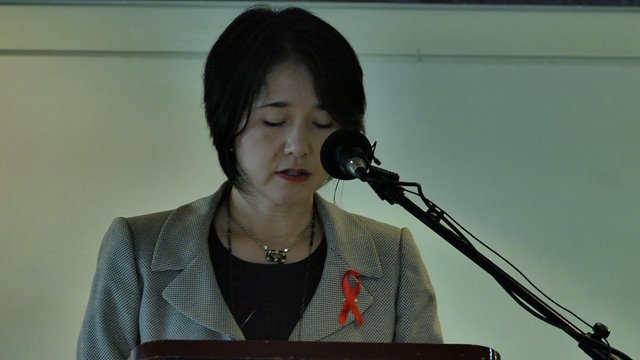Posted on 12/03/2012
 HIV
INTERVENTION. Chiyo Kanda, Acting Country Director for the Philippines
of the World Bank, expressed support for helping the country mitigate
HIV/AIDS. Photo by Adrian Portugal.
HIV
INTERVENTION. Chiyo Kanda, Acting Country Director for the Philippines
of the World Bank, expressed support for helping the country mitigate
HIV/AIDS. Photo by Adrian Portugal.MANILA, Philippines - HIV prevalence can be controlled and mitigated, according to multilateral lender Asian Development Bank (ADB).
This is the goal of two new projects aimed at curbing the growth and risks of HIV through a "focused and strategic approach," ADB Vice-President Stephen Groff said on Monday, December 3, two days after World Aids Day.
"These two projects will hopefully showcase the effectiveness of a focused and strategic approach to tackling HIV, AIDS and epidemics," he said.
The Myanmar project, known as Subproject 11: Strengthening Local Response to Address HIV Risks along the Economic Corridors in Myanmar, has been approved by ADB in its efforts to increase global response to the virus. A similar technical assistance project for the Philippines, entitled HIV Prevention in Big Cities in the Philippines, is in the process of being finalized.
Myanmar and the Philippines were chosen for specific reasons.
Myanmar is ranked as a high-burden country in Asia. With 240,000 people living with HIV in Myanmar, it is one of the countries with the largest number of HIV infections in the region.
The Philippines, on the other hand, is one of 7 countries in the region that continues to see an increase in its number of newly infected people--even while infections have drastically reduced in the region.
9 new cases a day
In creating the project for the Philippines, the ADB and the World Bank, which also contributed to the efforts, worked in partnership with the Department of Health (DOH).
Groff said the project "will focus on high quality services provision, providing information to targeted groups, and advocacy among key holders."
According to DOH Assistant Secretary Enrique Tayag, 21,000 Filipinos are projected to be living with HIV, a number that is expected to be close to 40,000 by 2015 if the issue is not tackled.
The DOH estimates about 9 new cases of HIV/AIDS in the Philippines every day.
Tayag also cited changing trends of the virus over time. From females, those infected with HIV/AIDS are now predominantly males, with a significant proportion being men who engage in sexual activity with other men. There is also a growing number of infected young people.
Most of the cases are in NCR (51%), while the regions of Central Luzon, Calabarzon, Central Visayas and Davao also had higher prevalence rates compared to the rest of the country.
Because of the numbers, the Philippine project will target key effective areas in Metro Manila and Metro Cebu.
"We have categorized cities that are vulnerable… we know now where the problem lies," said Tayag. "Next, we need investments… we invest in prevention, in strengthening health systems and more for treatment, care and support if needed."
Getting to zero
The vision and goal of ADB in relation to HIV/AIDS is getting to zero: zero new infections, zero discrimination and zero AIDS-related deaths.
Analysts believe the virus can be erased completely, but emphasized the need to tackle the problem head on.
World Bank Acting Country Director for the Philippines Chiyo Kanda said that in studying other countries in Asia that have drastically reduced new HIV infections, two factors stood out.
"Openness and innovation are important to the response," Kanda said.
She added that successful countries were open to their epidemics, and thus scaled up interventions, challenged stigma and encouraged public debate, which all resulted in successful intervention.
In Asia, Nepal has decreased HIV infection by 91% in the past decade, while Cambodia reduced theirs by 88%. India, Myanmar, Papua New Guinea and Thailand also reduced new infections by more than 50% from 2001-2011.
The Philippines however, has not been as succesful. Along with Bangladesh, Georgia, Indonesia, Kasakhstan, Kyryzstan and Sri Lanka, it has seen a 25% increase during the same period.
But Tayag said he is optimistic in decreasing HIV infection rates in the Philippines. He said prevention intervention such as the ADB project that will soon be launched, and the Reproductive Health bill which he said he hopes gets passed, can all help in curbing the growth of the virus
The projects are financed by the Cooperation Fund for Fighting HIV and AIDS in Asia and the Pacific, which is supported by the Government of Sweden. - Rappler.com



No comments:
Post a Comment